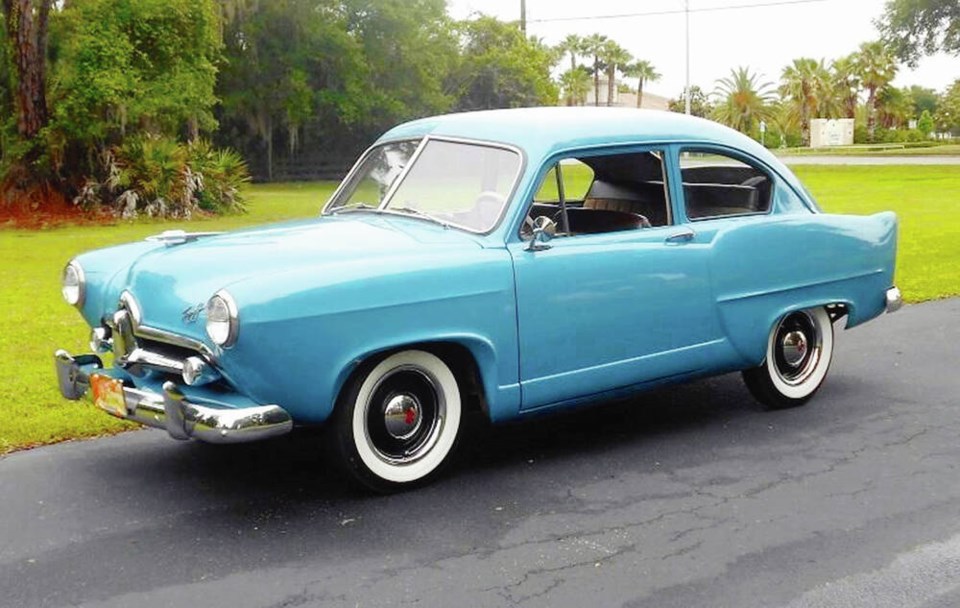Henry J. Kaiser and Joseph W. Frazer were keen to cash in on what they knew would be a huge pent-up demand for cars after the Second World War’s automobile production interruption.
Both were successful businessmen. Kaiser was a self-made millionaire who amassed a fortune in construction and shipbuilding in the western United States. He also built Second World War Liberty ships.
Frazer was an experienced automotive executive who worked his way up from mechanic’s helper at Packard, through automobile sales and eventually president and chairman of Graham-Paige Motors.
After a banker brought them together, Kaiser and Frazer formed a car company called Kaiser-Frazer Corp in 1945. It combined Kaiser’s money and enthusiasm, and Frazer’s extensive automotive knowledge and Graham-Paige interests.
K-F acquired the giant war surplus Willow Run bomber plant near Ypsilanti, Michigan, the world’s largest building under one roof, on favourable terms.
For years Kaiser had harboured dreams of building an economical, affordable small car, a kind of modern Model T Ford. But he would have to wait awhile to see his vision fulfilled. The first 1947 Kaisers and Frazers were conventional standard size, mid-priced cars competing with brands like Dodge, Pontiac and Mercury.
They prospered for a few years in the post-war seller’s market before Henry’s small-car dream came to fruition in 1951: K-F’s new two-door fastback Henry J compact.
To keep the price down, the Henry J was very basic. It lacked a trunk lid (the rear seat folded down), glove box and ventilation system. The interior was drab and cheap looking with upholstery called “Armour Weave Gray” and “Harness Weave Brown.” K-F advertised it as a car with “no unnecessary frills.”
The most distinctive styling cues were forward thrusting fenders, small pointed Cadillac-like rear fins and little “Darrin Dips” behind the doors and in the back window. They were a favourite mark of K-F stylist Howard “Dutch” Darrin.
While the Henry J bore some family resemblance to the beautiful full-sized 1951 Kaisers, its short 2540 mm (100 in.) wheelbase made it look somewhat tall and stubby with its 4432 mm (174.5 in.) overall length.
The Henry J came in Standard and Deluxe series with a 68 horsepower four cylinder in the Standard and 80 horsepower six in the Deluxe, both side-valve engines purchased from Willys-Overland.
The four’s performance was minimal, its purpose being to deliver economical transportation. The six was more spirited, with dealers boasting the Henry J “would beat an Olds 88,” the hot car then.
Road & Track (1/52) reported a modest zero to 60 mph (97 km/h) in 20 seconds for the 1,089 kg (2,400 lb) six, saying part of the reason for the leisurely acceleration was its “economy” rear axle. A Henry J did achieve 28.9 mpg (U.S.) in the Mobile Economy Run.
Top speed was 80 mph (129 km/h) and R&T’s impressions of the car were quite favourable.
Mechanix Illustrated’s Tom McCahill (8/50) who said it looked like “a Cadillac that started smoking too young,” reported zero to 60 (97) in 14.8 seconds with an overdrive-equipped six, and top speed of 87 to 90 mph (140-145 km/h). He was also favourably impressed by the Henry J.
A surprising 81,942 Henry Js were built in the first model year, compared with 70,003 rival Nash Ramblers. For 1952, improvements included a trunk lid and better quality interior. Moving the taillights to the points of the fins, a la Cadillac, improved rear end appearance.
An upgraded model called the Vagabond with optional continental spare tire was sold for a few months before being replaced by the Corsair. In spite of the improvements, sales slipped to only about 30,000 1952 Henry Js.
Also in 1952, the Chicago mail-order house Sears, Roebuck and Co., decided to return to the car business (Sears sold motor vehicles through their catalogue from 1908 to 1912). They lightly disguised a Henry J, rebadged it as the Sears Allstate and sold it through Sears stores.
The Allstate had a restyled grille, hubcaps and hood ornament. The interior was upgraded a little and it had Sears tires, spark plugs and battery. The venture lasted only two years with less than 2,400 Allstates sold.
Despite such 1953 “advancements” as a “Supersonic Six” engine, “Zero-Start” battery and “Sure-Stop” brakes, the Henry J slipped to some 17,000 model year sales. It was carried over for 1954 with no change but lasted only a few weeks; just over 1,100 1954 models were built before production ceased.
There were several reasons for the Henry J’s failure in the marketplace, the most prominent probably being that most American buyers didn’t seem very interested in small economy cars. The price was too close to standard large cars. Also, it was apparent that K-F was weakening and nobody wanted to be left with an “orphan.”



